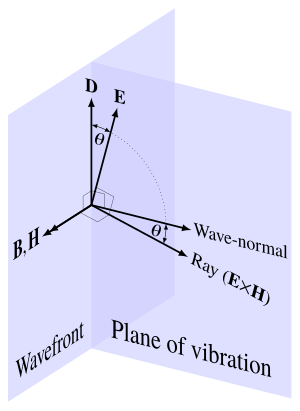
For light and other electromagnetic radiation, the plane of polarization is the plane spanned by the direction of propagation and either the electric vector or the magnetic vector, depending on the convention. It can be defined for polarized light, remains fixed in space for linearly-polarized light, and undergoes axial rotation for circularly-polarized light.
Unfortunately the two conventions are contradictory. As originally defined by Étienne-Louis Malus in 1811,[2] the plane of polarization coincided (although this was not known at the time) with the plane containing the direction of propagation and the magnetic vector.[3] In modern literature, the term plane of polarization, if it is used at all, is likely to mean the plane containing the direction of propagation and the electric vector,[4] because the electric field has the greater propensity to interact with matter.[5]
For waves in a birefringent (doubly-refractive) crystal, under the old definition, one must also specify whether the direction of propagation means the ray direction (Poynting vector) or the wave-normal direction, because these directions generally differ and are both perpendicular to the magnetic vector (Fig. 1). Malus, as an adherent of the corpuscular theory of light, could only choose the ray direction. But Augustin-Jean Fresnel, in his successful effort to explain double refraction under the wave theory (1822 onward), found it more useful to choose the wave-normal direction, with the result that the supposed vibrations of the medium were then consistently perpendicular to the plane of polarization.[6] In an isotropic medium such as air, the ray and wave-normal directions are the same, and Fresnel's modification makes no difference.
Fresnel also admitted that, had he not felt constrained by the received terminology, it would have been more natural to define the plane of polarization as the plane containing the vibrations and the direction of propagation.[7] That plane, which became known as the plane of vibration, is perpendicular to Fresnel's "plane of polarization" but identical with the plane that modern writers tend to call by that name!
It has been argued that the term plane of polarization, because of its historical ambiguity, should be avoided in original writing. One can easily specify the orientation of a particular field vector; and even the term plane of vibration carries less risk of confusion than plane of polarization.[8]
- ^ Cite error: The named reference
lunney-weaire-2006was invoked but never defined (see the help page). - ^ Buchwald, 1989, p. 54.
- ^ Stratton, 1941, p. 280; Born & Wolf, 1970, pp. 43, 681.
- ^ Cite error: The named reference
luntzwas invoked but never defined (see the help page). - ^ Born & Wolf, 1970, p. 28.
- ^ Fresnel, 1827, tr. Hobson, p. 318.
- ^ Fresnel, 1822, tr. Young, part 7, p. 406.
- ^ Born & Wolf, 1970, pp. 28, 43.
© MMXXIII Rich X Search. We shall prevail. All rights reserved. Rich X Search
